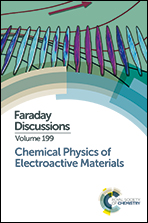Electro-responsive polyelectrolyte-coated surfaces
Abstract
The anchoring of polymer chains at solid surfaces is an efficient way to modify interfacial properties like the stability and rheology of colloidal dispersions, lubrication and biocompatibility. Polyelectrolytes are good candidates for the building of smart materials, as the polyion chain conformation can often be tuned by manipulation of different physico-chemical variables. However, achieving efficient and reversible control of this process represents an important technological challenge. In this regard, the application of an external electrical stimulus on polyelectrolytes seems to be a convenient control strategy, for several reasons. First, it is relatively easy to apply an electric field to the material with adequate spatiotemporal control. In addition, in contrast to chemically induced changes, the molecular response to a changing electric field occurs relatively quickly. If the system is properly designed, this response can then be used to control the magnitude of surface properties. In this work we discuss the effect of an external electric field on the adhesion and lubrication properties of several polyelectrolyte-coated surfaces. The influence of the applied field is investigated at different pH and salt conditions, as the polyelectrolyte conformation is sensitive to these variables. We show that it is possible to fine tune friction and adhesion using relatively low applied fields.
- This article is part of the themed collection: Chemical Physics of Electroactive Materials


 Please wait while we load your content...
Please wait while we load your content...